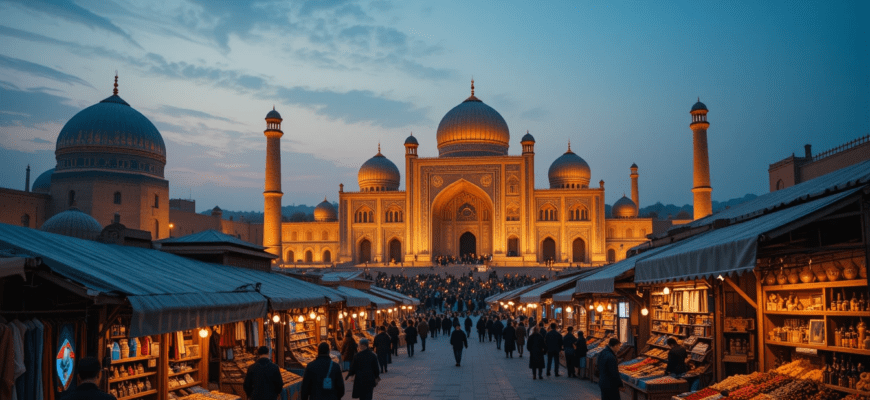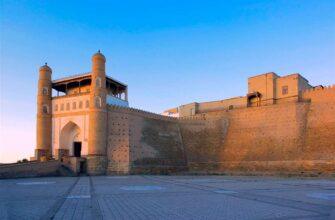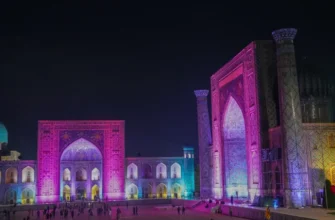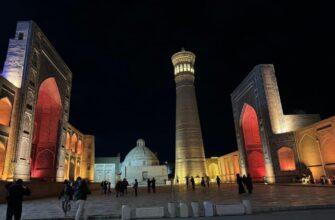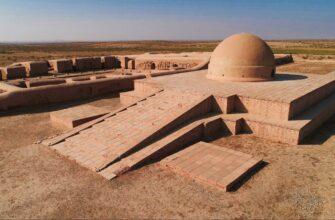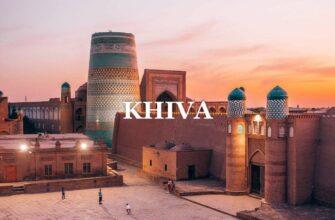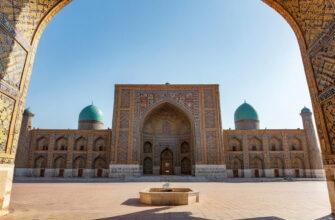Nestled in the heart of Uzbekistan, Samarkand is a city that feels like a page out of history, captivating travelers with its rich tapestry of culture and architecture. Known as one of the oldest continually inhabited cities in Central Asia, it served as a crucial stop on the Silk Road, bridging East and West.
With its breathtaking landmarks and vibrant local life, Samarkand offers an array of experiences that reflect the essence of its storied past. From the grandeur of monumental squares to the intricacies of artisan crafts, every corner reveals a piece of the city’s legacy, waiting to be explored.
In this article, we’ll delve into the top things to do in Samarkand, including a visit to the iconic Registan Square, the majestic Gur-e-Amir Mausoleum, and much more, inviting you to discover the unforgettable charm of this ancient gem.
The Registan Square: Heart of Samarkand
Registan Square is the heart of Samarkand and a must-visit attraction. This UNESCO World Heritage site is surrounded by three grand madrasahs: Ulugh Beg, Sher-Dor, and Tilya-Kori. These structures showcase the intricate Islamic architecture of the 15th to 17th centuries. Historically a central plaza for the Timurid capital, Registan Square was a hub for royal events, public gatherings, and a marketplace for artisans.
Visitors can marvel at the stunning mosaics and tilework during the day. At night, the buildings light up, creating a magical atmosphere. The name “Registan” means “sandy place” in Persian, recalling its origins when it was covered in sand. This square connects deeply to the Timurid dynasty’s history and significance.
A highlight of visiting here is during cultural events like the Sharq Taronalari music festival, held every other August. This adds a vibrant layer to the experience. Registan Square is more than just a historical site; it’s a modern center for cultural expression.
Things to Experience:
- Explore grand madrasahs
- Attend cultural festivals
- View architectural details
Whether you’re keen on history, architecture, or culture, Registan Square will amaze you.
Gur-e-Amir Mausoleum: Echoes of Tamerlane
The Gur-e-Amir Mausoleum stands as a symbol of architectural splendor in Samarkand. This iconic landmark is the final resting place of Amir Timur, also known as Tamerlane. Renowned for its stunning tile work and majestic interior, it is one of Uzbekistan’s most famous landmarks. The mausoleum features a unique turquoise cupola and lavish marble designs, inspiring structures like the Taj Mahal and Humayun’s Tomb.
Originally, Tamerlane did not intend to be buried here, but unforeseen events led to his interment alongside family and mentors. Inside, visitors can marvel at intricate gilded coatings and geometric panels, which radiate with stars, enhancing its beauty.
For a truly magical experience, return at night to witness the mausoleum’s enchanting glow.
Highlights of Gur-e-Amir Mausoleum:
- Turquoise Cupola: Distinctive and iconic.
- Lavish Marble Designs: Inspirational to other famous tombs.
- Intricate Interior: Features gilded coatings and geometric star panels.
- Night Visit: Experience its otherworldly glow.
Visitors to Samarkand will find the Gur-e-Amir Mausoleum a must-see, as it encapsulates the rich history and architectural brilliance of the city.
Shah-i-Zinda Necropolis: A Sacred Journey
Shah-i-Zinda, or “Living King” in Persian, is a stunning necropolis in Samarkand. Known for its rows of blue tombs, this site is a must-visit for those interested in history and architecture.
Key Highlights of Shah-i-Zinda
- Kusam ibn Abbas: Central to the site’s significance, Kusam ibn Abbas, a cousin of the Prophet Muhammad, is said to be buried here. This adds a layer of sacredness to the site.
- Intricate Design: The tombs are adorned with breathtaking turquoise tiles and intricate mosaics. The detailed Islamic calligraphy enhances the spiritual atmosphere.
- Spiritual and Historical Significance: It serves both as a place for pilgrimage and a location rich in history, attracting visitors who come to pray and explore.
This necropolis is not just a collection of tombs but a vibrant part of Samarkand’s spiritual and architectural heritage. A visit here offers a journey through centuries of history and art, making it a pivotal stop in any exploration of Samarkand.
Bibi-Khanym Mosque: A Testament to Grandeur
Bibi-Khanym Mosque, named after Timur the Great’s wife, stands as a symbol of grandeur in Samarkand. Built in the 15th century, this mosque was commissioned by Amir Timur. It was intended to be one of the largest and most magnificent mosques in the Islamic world. The mosque showcases Timurid Renaissance architecture, notable for its stunning blue domes and intricate mosaics.
Despite its splendid design, Bibi-Khanym Mosque faced structural issues. Timur’s ambitious vision and rapid construction led to compromised durability. Even so, the mosque remains about 80% restored. This provides a raw glimpse of its historical authenticity, unlike some over-polished sites in Uzbekistan.
Visitors can marvel at its grandeur and explore the connection between trade and religion nearby. The Siyob Bazaar, located close to the mosque, offers an immersive cultural experience. Here, you can explore a variety of local goods and traditional foods.
Highlights of Bibi-Khanym Mosque:
- Stunning Architecture: Features blue domes and mosaics.
- Historical Significance: Built under Amir Timur’s rule.
- Cultural Experience: Near Siyob Bazaar.
Bibi-Khanym Mosque is a must-visit for those interested in history and architecture.
Siyob Bazaar: A Taste of Local Culture
Siyob Bazaar offers a vibrant glimpse into the heart of Samarkand’s culture. Located next to the magnificent Bibi-Khanym Mosque, it is the city’s largest market. Here, visitors can enjoy a diverse array of local produce such as fruits, spices, nuts, and candies. Food lovers will have a field day exploring and tasting the goods offered by enthusiastic vendors eager to share their wares.
In addition to food, Siyob Bazaar is a treasure trove for unique Uzbek souvenirs. You can find clothing, scarves, hats, and beautifully hand-carved boxes. These items make perfect gifts and keepsakes. Despite its popularity with tourists, the bazaar retains its authentic charm. The bustling atmosphere with its sights, sounds, and aromas is a true reflection of daily life in Samarkand.
Here’s a quick guide on what you can find:
| Category | Items |
|---|---|
| Food | Fruits, spices, nuts, candies, vegetables |
| Souvenirs | Clothing, scarves, hats, trinkets, hand-carved boxes |
Siyob Bazaar is a must-visit for experiencing the local culture and shopping in Samarkand.
Ulugh Beg Observatory: Stargazing Through History
The Ulugh Beg Observatory, built in the 1420s by the Timurid ruler Ulugh Beg, stands as a testament to Samarkand’s scientific heritage. Founded by the grandson of Amir Timur, this remarkable site was once a hub for astronomical study.
Key Features:
- Meridian Arc: The observatory featured a monumental 40-meter meridian arc, the main tool for measuring the angle of celestial objects.
- Star Catalogue: Ulugh Beg’s greatest achievement was a star catalogue of over 1,000 stars. This was developed 200 years before telescopes were invented.
Although much of the original structure is gone, the site now houses a museum. Visitors can explore Ulugh Beg’s star charts and astronomical instruments, offering insights into the history of astronomy.
The observatory marks one of the greatest advancements in astronomy of its time. It highlights the rich scientific contributions from this ancient city. If you’re exploring Samarkand, the Ulugh Beg Observatory is a must-visit for history and science lovers alike.
Afrasiab Archaeological Site: Uncovering Ancient Civilizations
The Afrasiab Archaeological Site is a captivating window into ancient civilizations. Believed to be the legendary Marakanda, this site was the capital of Sogdiana around the 5th century BC. It was inhabited until the late Middle Ages. Long before Tamerlane, this area thrived with advanced societies.
Visitors can wander through the ruins of a hillside city. Among the highlights are a decorated palace, a strong fortress, residential areas, and bathhouses. Water pipes and an artisan center reveal the area’s advanced infrastructure.
Here’s what you can find at the Afrasiab site:
- Decorated Palace: Intricate designs hint at its grandeur.
- Fortress: Offers insights into ancient defensive strategies.
- Living Quarters: See how people lived centuries ago.
- Artisan Center: A hub of creativity and craft.
The Afrasiab Museum complements the site. It showcases stunning palace frescoes and other treasures, reflecting its glorious past. This is an ideal spot for those eager to explore Uzbekistan’s ancient history. It’s a raw and real journey back in time that captivates and educates.
Local Wineries: Savoring Uzbek Hospitality
When in Samarkand, sampling local wines offers a delightful taste of Uzbek hospitality. Uzbekistan’s wines are well-regarded, and one of the best ways to experience them is through a wine tasting tour. The Khovrenko Winery is a top choice, providing samples of both local wines and cognacs. They even offer transportation from your hotel, making it convenient for visitors.
Another spot to check out is the Museum of Wine Making in Samarkand. Here, guests can enjoy more wine tasting experiences. However, securing a reservation can be tricky. Visiting in a group might feel rushed due to timing constraints, so it’s best to plan ahead.
Experiencing a wine tasting session in Samarkand allows you to appreciate the unique qualities of Uzbek wines. Each taste invites you into the heart of the region’s rich culinary scene. Whether at Khovrenko or the Museum, you’re sure to find flavors that capture the essence of this ancient city.
List of Wine Tasting Spots in Samarkand:
- Khovrenko Winery
-
- Local wines and cognacs
- Hotel transport available
- Museum of Wine Making
-
- Wine tasting experiences
- Reservation needed
Artisan Workshops: Crafts and Traditions
Samarkand is a treasure trove of artisan workshops that offer a glimpse into its rich cultural heritage. Visitors can witness traditional silk carpet weaving at local factories. Here, you can see the entire process unfold, from silkworms to the final woven masterpiece. These demonstrations showcase a unique blend of old techniques and modern designs, making the carpets a sought-after souvenir.
Another highlight is the Museum of Wine Making, where you can taste regional wines. This experience reflects the local craftsmanship and culinary traditions. It’s a great way to understand the flavors and history of the region.
Exploring the artisan workshops around the city allows visitors to appreciate the skill involved in creating these handcrafted goods. The workshops are a testament to Samarkand’s dedication to preserving its cultural craftsmanship.
Things to Do in Artisan Workshops:
- Watch silk carpet weaving.
- Taste wines at the Museum of Wine Making.
- Explore artisan skills and craftsmanship.
Each visit to these workshops adds a layer of understanding to the ancient city’s vibrant culture and traditions. Whether you’re a crafts enthusiast or a curious traveler, the artisan workshops in Samarkand are worth exploring.
Timurid Museum: A Peek into Samarkand’s Heritage
The Timurid Museum in Samarkand offers a fascinating glimpse into the architectural and cultural legacy of the Timurid Empire. Founded by Timur the Great in the late 14th century, this empire made Samarkand a hub for arts and Islamic learning. The Timurid architectural style, characterized by grandeur and intricate designs, emerged during this vibrant period.
Here are some highlights of the museum:
- Exhibits: Display artifacts from the Timurid era, showcasing the empire’s contributions to art and architecture.
- Restored Monuments: Many of Samarkand’s stunning buildings were restored by the Soviets, emphasizing their historical importance.
- Key Sites: The Amir Timur Mausoleum, a notable landmark related to the dynasty, highlights the lasting impact of their rule.
Why visit the Timurid Museum? It provides invaluable insight into Central Asia’s history and the unique Timurid architecture. With its blue domes and intricate designs, the museum stands as a testament to the cultural achievements of the Timurid Empire. Whether you are a history buff or an architecture enthusiast, the Timurid Museum promises an enriching experience.

